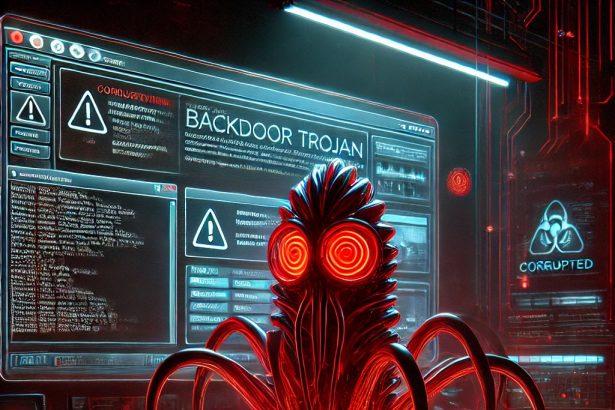Cybercriminals are evolving their attack methods, now exploiting AI coding assistants by embedding hidden instructions in configuration files. Known as the Rules File Backdoor Attack, this emerging threat manipulates AI models into generating compromised code, bypassing traditional security measures. What makes this attack especially dangerous is its ability to spread undetected across multiple projects, posing a persistent supply chain risk to organizations relying on AI-driven development.
Key Details of the Threat
The table below summarizes the essential details of the Rules File Backdoor Attack:
| Category | Details |
|---|---|
| Threat Type | AI Configuration File Manipulation, Supply Chain Attack |
| Associated Email Addresses | N/A |
| Detection Names | May vary by security vendor, but often classified as Trojan.AI.Backdoor, Malicious Code Injection, AI-Poisoning |
| Symptoms of Infection | AI-generated code contains unexpected backdoors, security flaws, or obfuscated functions |
| Damage | Can lead to compromised software, unauthorized access, data breaches, and long-term espionage |
| Distribution Methods | Hidden commands in AI rules files, malicious repository contributions, and tampered open-source libraries |
| Danger Level | Critical – Persistent, difficult to detect, and widespread impact across software supply chains |
How the Rules File Backdoor Attack Works
Hackers take advantage of AI assistants that rely on rule-based configuration files to guide code generation. By embedding invisible Unicode characters, bidirectional text markers, and obfuscated commands, attackers deceive AI models into generating insecure code, backdoors, or other vulnerabilities.
Once a compromised rules file is introduced into a repository, it continues influencing all subsequent AI-assisted coding sessions, affecting projects across the supply chain. The threat is particularly insidious because it does not target an individual system directly but compromises widely used AI-based development tools, impacting millions of developers worldwide.
Why This Attack is So Dangerous
Unlike conventional malware, this attack exploits the trust and automation of AI-driven development environments. Some key risks include:
- Persistent Supply Chain Risk: Once a repository is compromised, every project that interacts with it becomes vulnerable.
- Stealthy Manipulation: The AI assistant unwittingly generates malicious code without triggering security alarms.
- Widespread Impact: Forked projects and dependencies inherit the compromised instructions, propagating the attack.
- Trust Exploitation: Organizations trust AI tools to streamline development, making them unsuspecting victims.
The Bigger Picture: Supply Chain Attacks
The Rules File Backdoor Attack is part of a broader category of supply chain malware attacks, which target trusted software, hardware, or services before they reach end users. Unlike direct attacks, supply chain threats are particularly devastating due to their stealth, scale, and ability to exploit trust.
- Mass Infection Potential: Since AI-generated code is widely used, a single compromised repository could impact thousands of applications.
- Bypassing Traditional Security: AI-generated suggestions often evade manual review, allowing vulnerabilities to slip through undetected.
- Long-Term Threat: The attack can persist for months or even years, spreading across projects without raising alarms.
Manual Removal of Backdoor Malware
(Note: Manual removal can be complex and risky. If performed incorrectly, it may cause system instability. Proceed with caution or use the automated SpyHunter method below.)
Step 1: Restart in Safe Mode with Networking
To prevent the backdoor malware from running, restart your computer in Safe Mode with Networking:
- Press Windows + R, type
msconfig, and press Enter. - Navigate to the Boot tab.
- Check Safe boot and select Network.
- Click Apply > OK and restart your PC.
Step 2: Terminate Malicious Processes in Task Manager
- Press Ctrl + Shift + Esc to open Task Manager.
- Look for suspicious processes that may be linked to the backdoor malware. Common signs include:
- Unrecognized processes consuming high CPU or memory.
- Randomly named processes (e.g.,
svchost32.exe,systemupdate.exe).
- Right-click on any suspicious process and select End Task.
Step 3: Delete Suspicious Files from System Folders
- Press Windows + R, type
%AppData%and press Enter. - Check for suspicious folders and files, such as unknown
.exeor.dllfiles. - Navigate to the following locations and remove suspicious files:
C:\Users\YourUserName\AppData\LocalC:\Users\YourUserName\AppData\RoamingC:\ProgramDataC:\Windows\System32\driversC:\Windows\Temp
Step 4: Remove Malicious Entries from the Windows Registry
- Press Windows + R, type
regedit, and hit Enter. - Navigate to the following keys:
HKEY_LOCAL_MACHINE\SOFTWARE\Microsoft\Windows\CurrentVersion\RunHKEY_CURRENT_USER\Software\Microsoft\Windows\CurrentVersion\Run
- Look for entries with random names or unknown applications.
- Right-click and select Delete.
(Caution: Editing the Registry incorrectly can cause serious issues. Back up your registry before making changes.)
Step 5: Reset Browser Settings
Backdoor malware may modify browser settings to redirect traffic or steal credentials. Reset your browsers:
Google Chrome
- Open Chrome, type
chrome://settings/resetin the address bar, and press Enter. - Click Restore settings to their original defaults > Reset settings.
Mozilla Firefox
- Open Firefox, type
about:supportin the address bar, and press Enter. - Click Refresh Firefox > Confirm.
Microsoft Edge
- Open Edge, go to Settings > Reset Settings.
- Click Restore settings to their default values > Reset.
Step 6: Scan for Remaining Threats
After manual removal, use Windows Defender or a third-party antivirus to scan your system for remaining threats.
- Press Windows + I > Update & Security > Windows Security.
- Click Virus & threat protection > Quick Scan.
Remove Backdoor Malware with SpyHunter (Recommended)
SpyHunter is a powerful anti-malware tool that can detect and remove backdoor malware without requiring technical expertise.
Step 1: Download SpyHunter
- Go to the official SpyHunter download page: Download SpyHunter
- Click the Download Now button.
Step 2: Install SpyHunter
- Locate the downloaded
SpyHunter-Installer.exefile and double-click it. - Follow the on-screen instructions to complete the installation.
- Launch SpyHunter after installation.
Step 3: Perform a Full System Scan
- Click Start Scan Now.
- SpyHunter will scan your system for backdoor malware and other threats.
- Once the scan is complete, review the detected threats.
Step 4: Remove Detected Malware
- Click Fix Threats to remove all detected malware.
- If prompted, restart your computer to complete the removal process.
Step 5: Enable SpyHunter's Real-Time Protection
To prevent future infections:
- Open SpyHunter and go to Settings.
- Enable Real-Time Malware Protection.
- Keep SpyHunter updated to stay protected against the latest threats.
How to Prevent Backdoor Malware Infections
- To keep your system safe, follow these security best practices:
- Avoid downloading cracked software – Many backdoors hide in illegal downloads.
- Keep Windows and software updated – Install security patches regularly.
- Use strong passwords – Prevent unauthorized remote access.
- Enable two-factor authentication (2FA) – Adds an extra security layer.
- Scan email attachments before opening – Phishing emails often carry malware.
- Use a firewall – Block unauthorized network connections.
Conclusion
The Rules File Backdoor Attack represents a new frontier in cyber threats, demonstrating how AI can be weaponized against its users. By manipulating AI coding assistants through hidden instructions in configuration files, attackers create a silent, persistent supply chain risk that compromises software security across industries. As AI continues to revolutionize software development, the responsibility of reviewing and securing AI-generated code falls heavily on developers and security teams. Without proactive defense strategies, organizations may unknowingly introduce backdoors into their own applications, endangering users and businesses worldwide.
SEO Keywords
AI coding assistant security, AI-generated malware, AI backdoor attack, AI supply chain risk, Rules file backdoor, AI configuration file attack, malicious AI coding rules, software supply chain attack, AI poisoning, AI-assisted coding vulnerabilities, hidden Unicode malware, AI trust exploitation, AI security breach, cybersecurity threats 2025, software vulnerability exploitation.



